In Situ Observations of Blistering of a Metal Irradiated with 2-MeV Protons
Abstract
:1. Introduction
2. Experimental Apparatus
3. Experimental Results
3.1. Series I
3.2. Series II
3.2.1. Sample 1
3.2.2. Samples 2 and 3
3.2.3. Sample 4
3.2.4. Samples 5 and 6
3.2.5. Samples 7, 8 and 9
4. Generalizations and Discussion
- The blistering threshold of the copper surface depends on the copper purity. The purer the copper, the higher the threshold is. The maximum threshold is 3 × 1019 cm−2; the minimum value is seven times lower.
- The size of the blisters on the copper surface depends on the copper purity. The purer the copper, the larger the blisters are. Blister size ranges from 40 ± 20 to 160 ± 50 μm.
- No dependence of the blistering threshold on the copper crystallite orientation was found.
- Once blisters appear on the copper surface, further irradiation does not cause any more surface modification, which can be due to the formation of holes and cracks when blisters emerge.
- The attachment of a thin tantalum foil to copper by explosion or diffusion welding as well as soldering is resistant to a heat load of up to 1 kW/cm2.
- Tantalum is much more resistant to the formation of blisters than copper. The threshold of blisters in the form of bubbles or flakes on the tantalum surface exceeds 6.7 × 1020 cm−2. At a fluence of 3.6 × 1020 cm−2 the surface is modified in the form of a relief with a characteristic cell size of 1 μm.
- During tantalum irradiation, an increase in the sample surface temperature was detected. This could be due to a decrease in the thermal conductivity because of the appearance of cavities and hydrogen incorporation into the tantalum crystal structure.
- Ultra-pure copper can be used to prepare a substrate for the target in the therapy of several patients (approximately 20).
- It is not obvious that after the appearance of blisters on the surface of the copper substrate the target cannot continue to be used to generate neutrons. This is because accumulated hydrogen can escape through holes and cracks formed when blisters emerge. Furthermore, a decrease in the thermal conductivity caused by blisters will not be critical for lithium melting.
- The application of a thin tantalum layer deposited on the heat-removing copper substrate increases the target resistance to blistering by no less than ten times as compared to the most stable copper substrate.
- Proton absorption in the tantalum layer of the target decreases the thermal conductivity due to the formation of cavities and hydrogen incorporation into the tantalum crystal structure, and consequently, leads to a significant increase in the lithium temperature, which can be critical even without surface modification by blisters.
5. Conclusions
Acknowledgments
Author Contributions
Conflicts of Interest
References
- Sauerwein, W.; Wittig, A.; Moss, R.; Nakagawa, Y. Neutron Capture Therapy: Principles and Applications; Springer: Berlin/Heidelberg, Germany, 2012; p. 553. ISBN 978-3-642-31334-9. [Google Scholar]
- Taskaev, S.; Kanygin, V. Boron Neutron Capture Therapy; Publishing House of Siberian Branch of Russian Academy of Sciences: Novosibirsk, Russia, 2016; p. 216. ISBN 978-5-7692-1500-1. [Google Scholar]
- Taskaev, S. Accelerator based epithermal neutron source. Phys. Part. Nucl. 2015, 46, 956–990. [Google Scholar] [CrossRef]
- Bayanov, B.; Belov, V.; Bender, E.; Bokhovko, M.; Dimov, G.; Kononov, V.; Kononov, O.; Kuksanov, N.; Palchikov, V.; Pivovarov, V.; et al. Accelerator based neutron source for the neutron-capture and fast neutron therapy at hospital. Nucl. Instrum. Methods Phys. Res. Sect. 1998, 413, 397–426. [Google Scholar] [CrossRef]
- Bayanov, B.; Belov, V.; Kindyuk, V.; Oparin, E.; Taskaev, S. Lithium neutron producing target for BINP accelerator-based neutron source. Appl. Radiat. Isot. 2004, 61, 817–821. [Google Scholar] [CrossRef] [PubMed]
- Bayanov, B.; Belov, V.; Taskaev, S. Neutron producing target for accelerator based neutron capture therapy. J. Phys. Conf. Ser. 2006, 41, 460–465. [Google Scholar] [CrossRef]
- Kasatov, D.; Makarov, A.; Taskaev, S.; Shchudlo, I. Radiation accompanying the absorption of 2-MeV protons in various materials. Phys. At. Nucl. 2015, 78, 905–911. [Google Scholar] [CrossRef]
- Behrisch, R. Sputtering by Particle Bombardment II; Springer: New York, NY, USA, 1984; ISBN 978-3662311691. [Google Scholar]
- Guseva, M.; Martynenko, Y.V. Radiation blistering. Sov. Phys. Uspekhi 1981, 24, 996–1007. [Google Scholar] [CrossRef]
- Astrelin, V.; Burdakov, A.; Bykov, P.; Ivanov, I.; Ivanov, A.; Jongen, Y.; Konstantinov, S.; Kudryavtsev, A.; Kuklin, K.; Mekler, K.; et al. Blistering of the selected materials irradiated by intense 200 keV proton beam. J. Nucl. Mater. 2010, 396, 43–48. [Google Scholar] [CrossRef]
- Volkova, O.; Mechetina, L.; Taranin, A.; Zaboronok, A.; Nakai, K.; Lezhnin, S.; Frolov, S.; Kasatov, D.; Makarov, A.; Sorokin, I.; et al. Impact of neutron radiation on the viability of tumor cells cultured in the presence of boron-10 isotope. Vestnik Rentgen. Radiol. 2016, 97, 283–288. [Google Scholar] [CrossRef]
- Ivanov, A.; Kasatov, D.; Koshkarev, A.; Makarov, A.; Ostreinov, Y.M.; Sorokin, I.; Taskaev, S.; Shchudlo, I. Obtaining a proton beam with 5-mA current in a tandem accelerator with vacuum insulation. Tech. Phys. Lett. 2016, 42, 608–611. [Google Scholar] [CrossRef]
- Burdakov, A.V.; Kuznetsov, A.S.; Bayanov, B.F.; Astrelin, V.T.; Mekler, K.I.; Sulyaev, Y.S. Graphite targets for experiments on GRA detection of nitrogen containing materials. Prikl. Fiz. Appl. Phys. 2016, 3, 69–74. [Google Scholar]
- Andersen, H.; Ziegler, J. Hydrogen Stopping Powers and Ranges in All Elements (The Stopping and Ranges of Ions in Matter); Pergamon Press Inc.: Oxford, UK, 1977; Volume 3, ISBN 978-0080216058. [Google Scholar]
- Kasatov, D.; Makarov, A.; Taskaev, S.; Shchudlo, I. Recording of current accompanying an ion beam in a tandem accelerator with vacuum insulation. Tech. Phys. Lett. 2015, 41, 139–141. [Google Scholar] [CrossRef]
- Ivanov, A.; Kasatov, D.; Koshkarev, A.; Makarov, A.; Ostreinov, Y.; Shchudlo, I.; Sorokin, I.; Taskaev, S. Suppression of an unwanted flow of charged particles in a tandem accelerator with vacuum insulation. J. Instrum. 2016, 11, 04018. [Google Scholar] [CrossRef]
- ICDD. Powder Diffraction File, PDF-2/Release 2016; International Centre for Diffraction Data: Newtown Square, PA, USA, 2016. [Google Scholar]
- Kraus, W.; Nolze, G. POWDER CELL—A program for the representation and manipulation of crystal structures and calculation of the resulting X-ray powder patterns. J. Appl. Crystallogr. 1996, 29, 301–303. [Google Scholar] [CrossRef]
- Waite, T.R.; Wallace, W.E.; Craig, R.S. Structures and phase relationships in the Tantalum-Hydrogen system between −145 and 70 °C. J. Chem. Phys. 1956, 24, 634–635. [Google Scholar] [CrossRef]

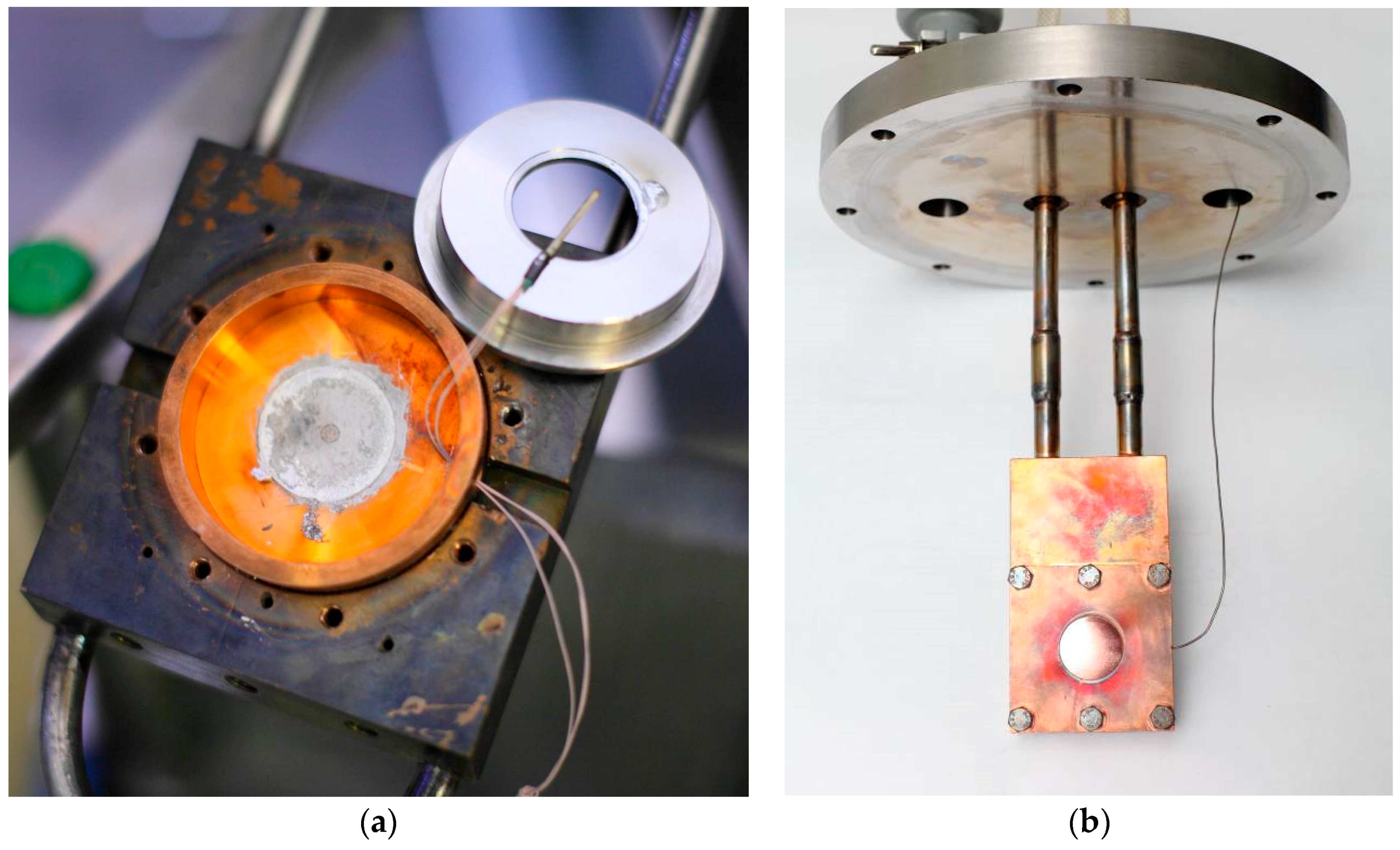
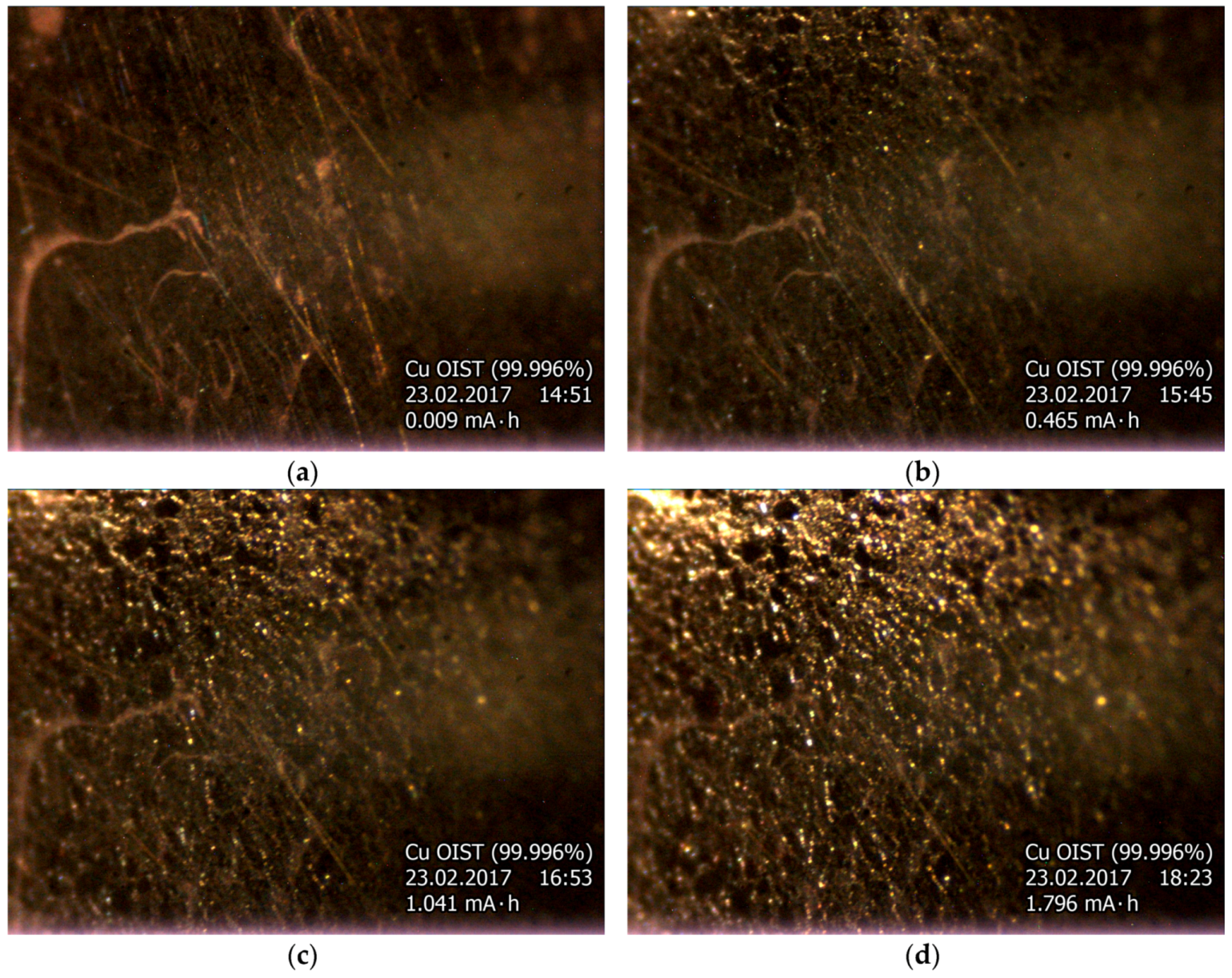
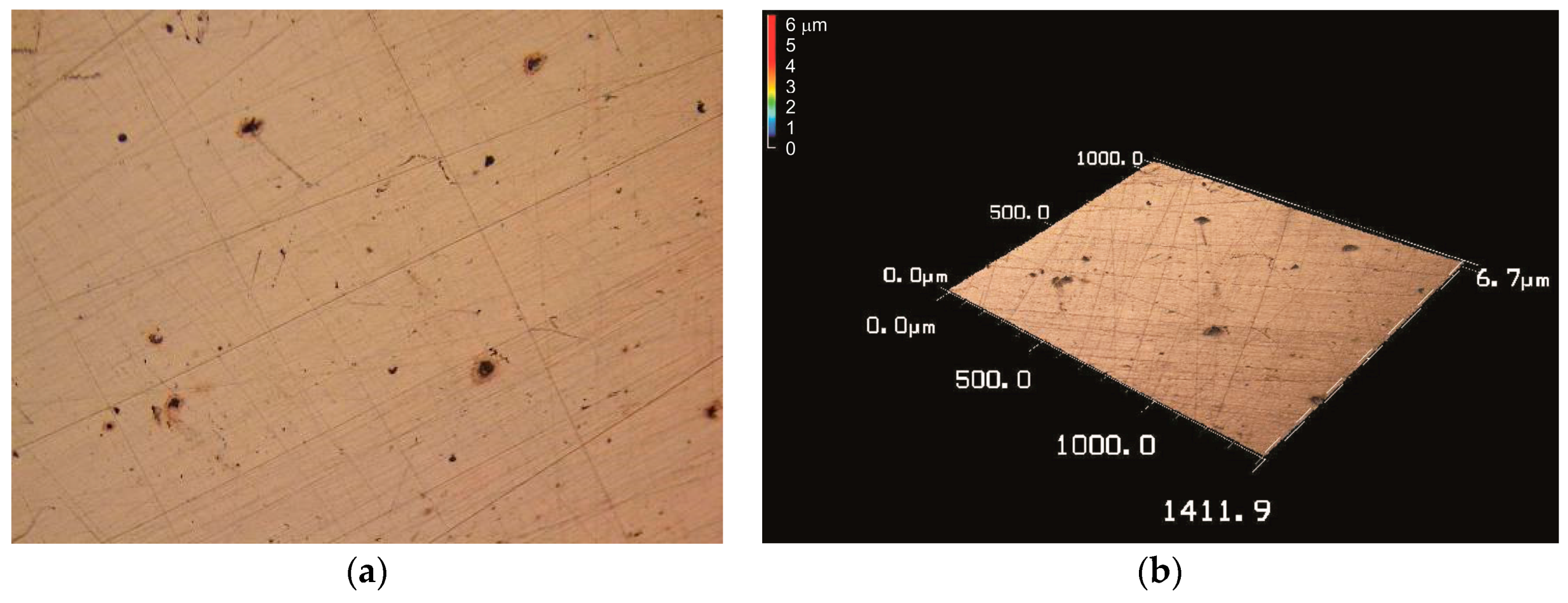
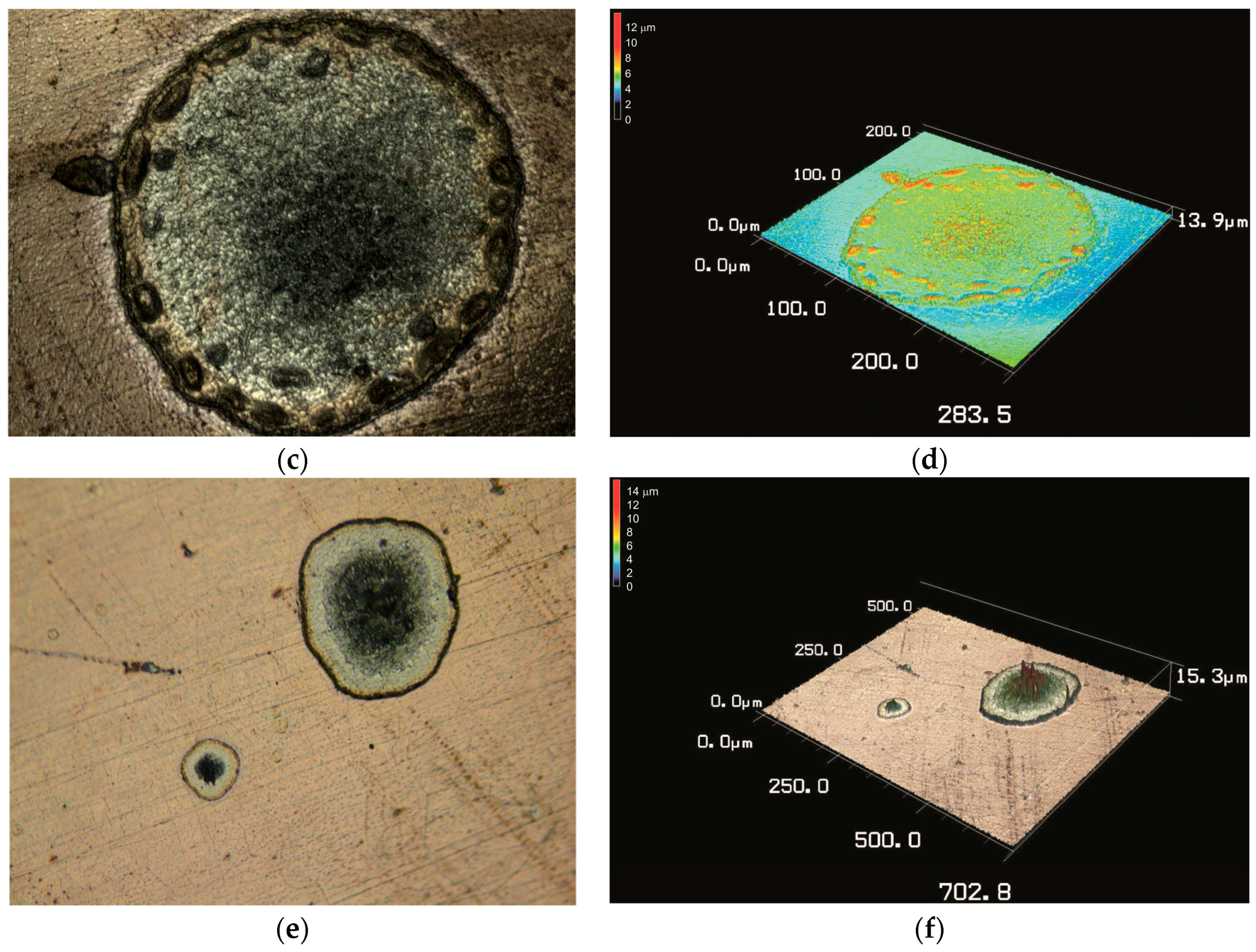

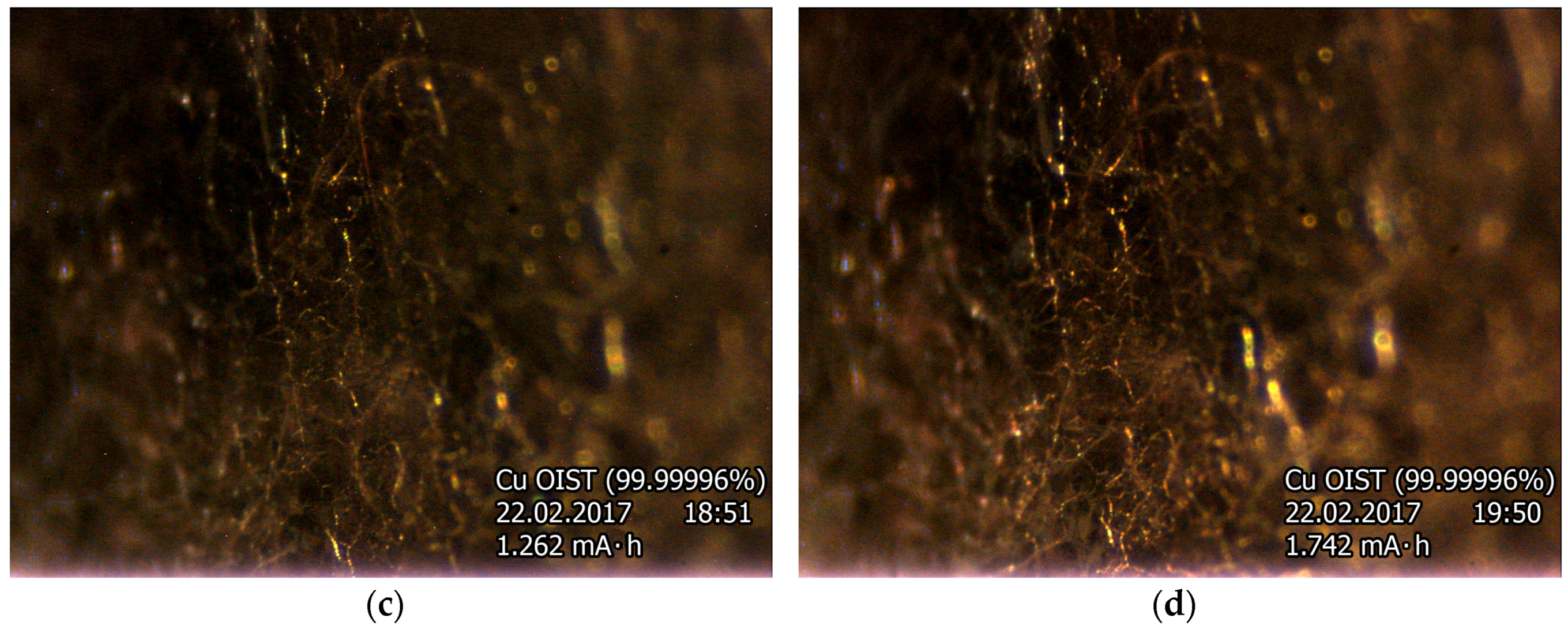

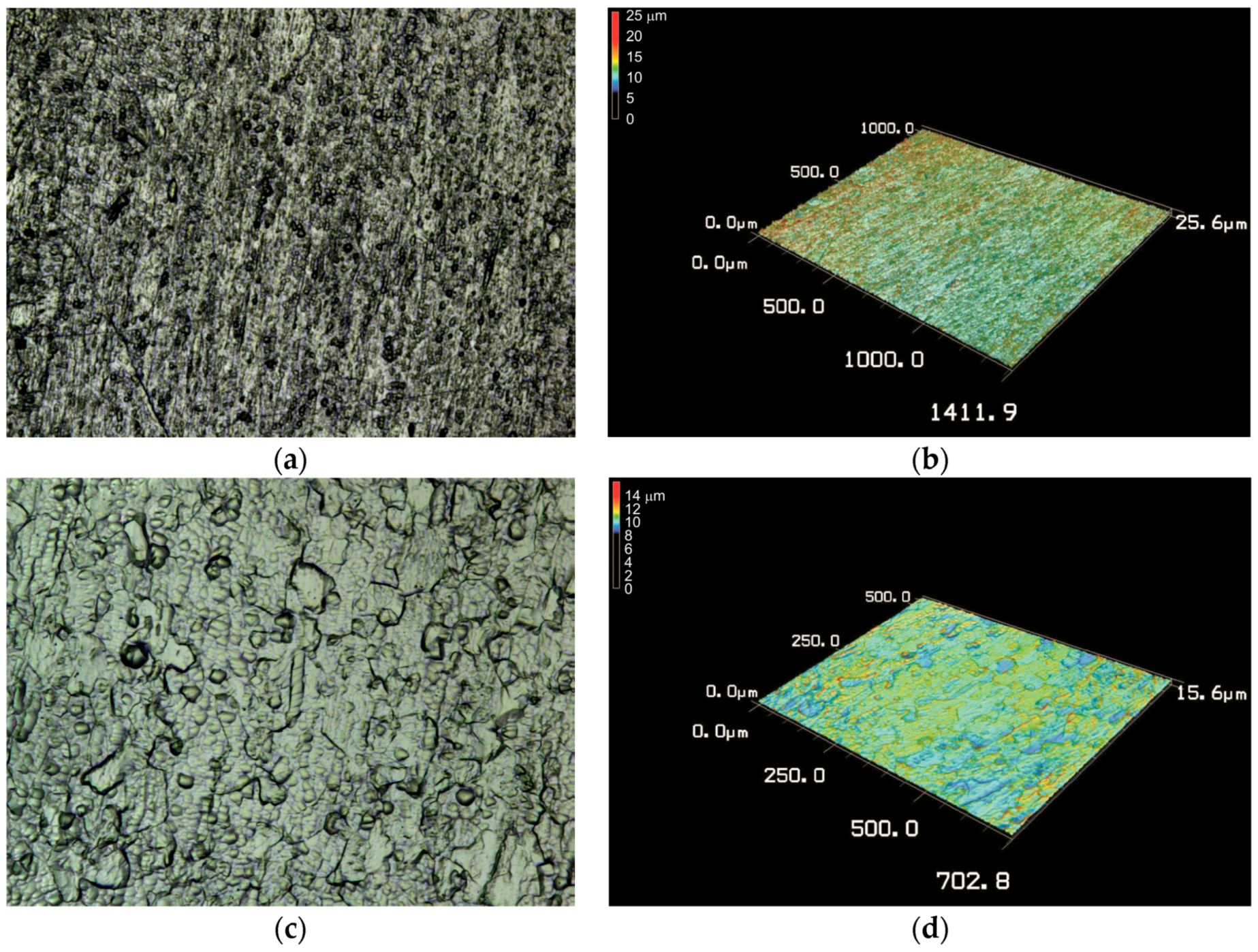
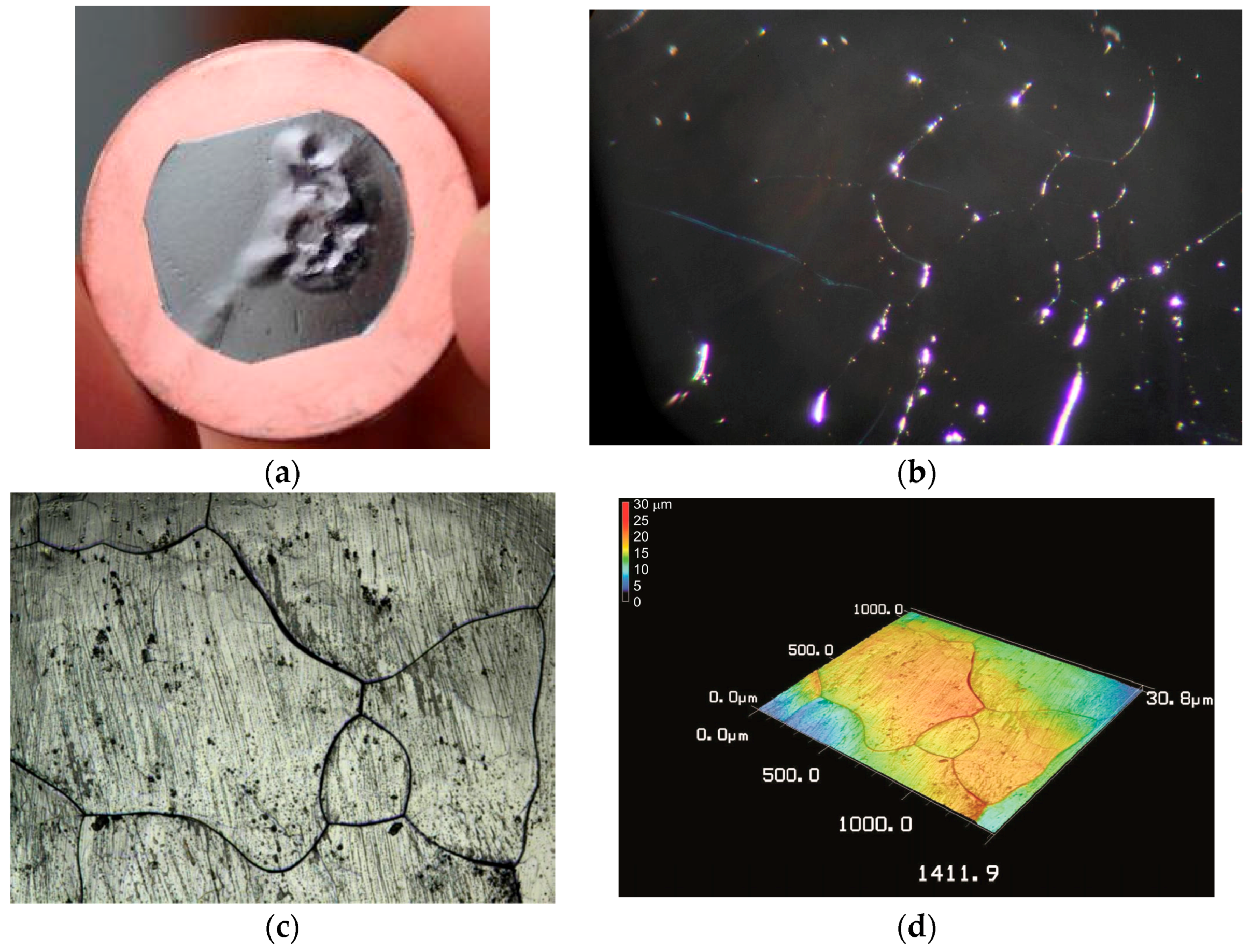
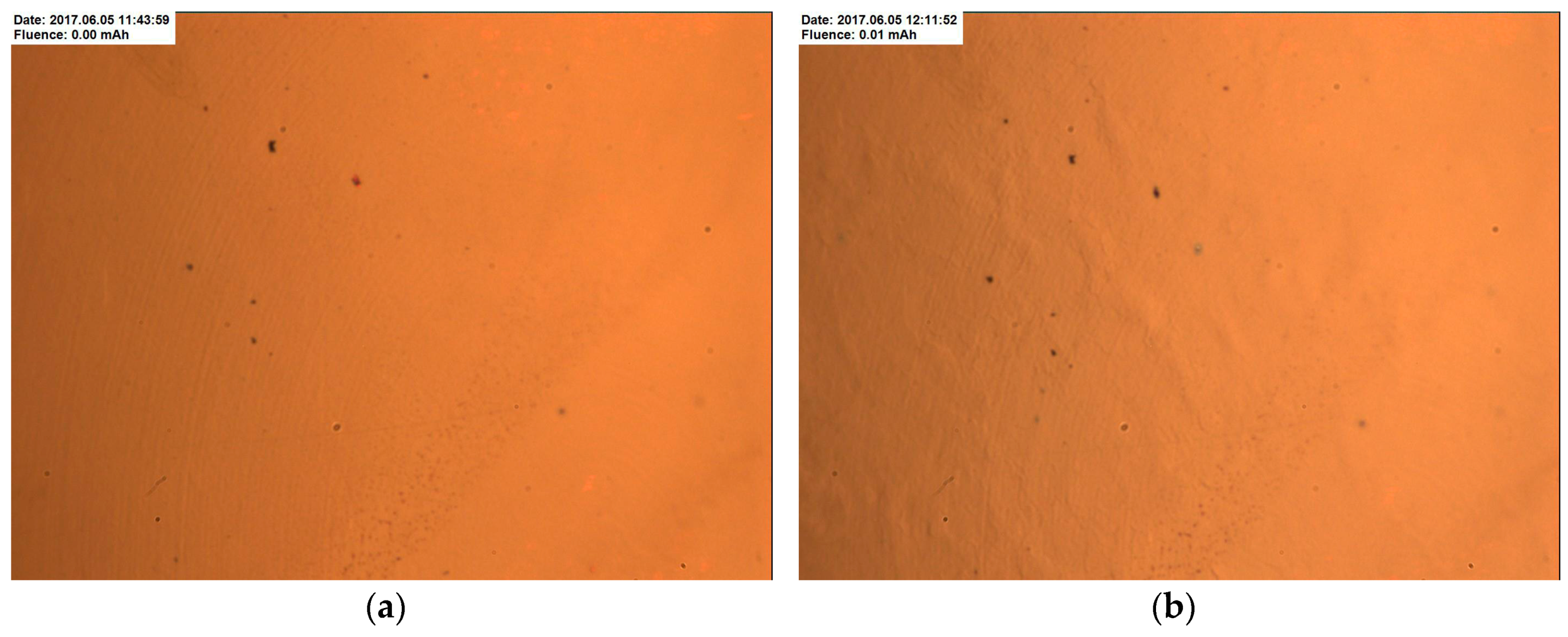
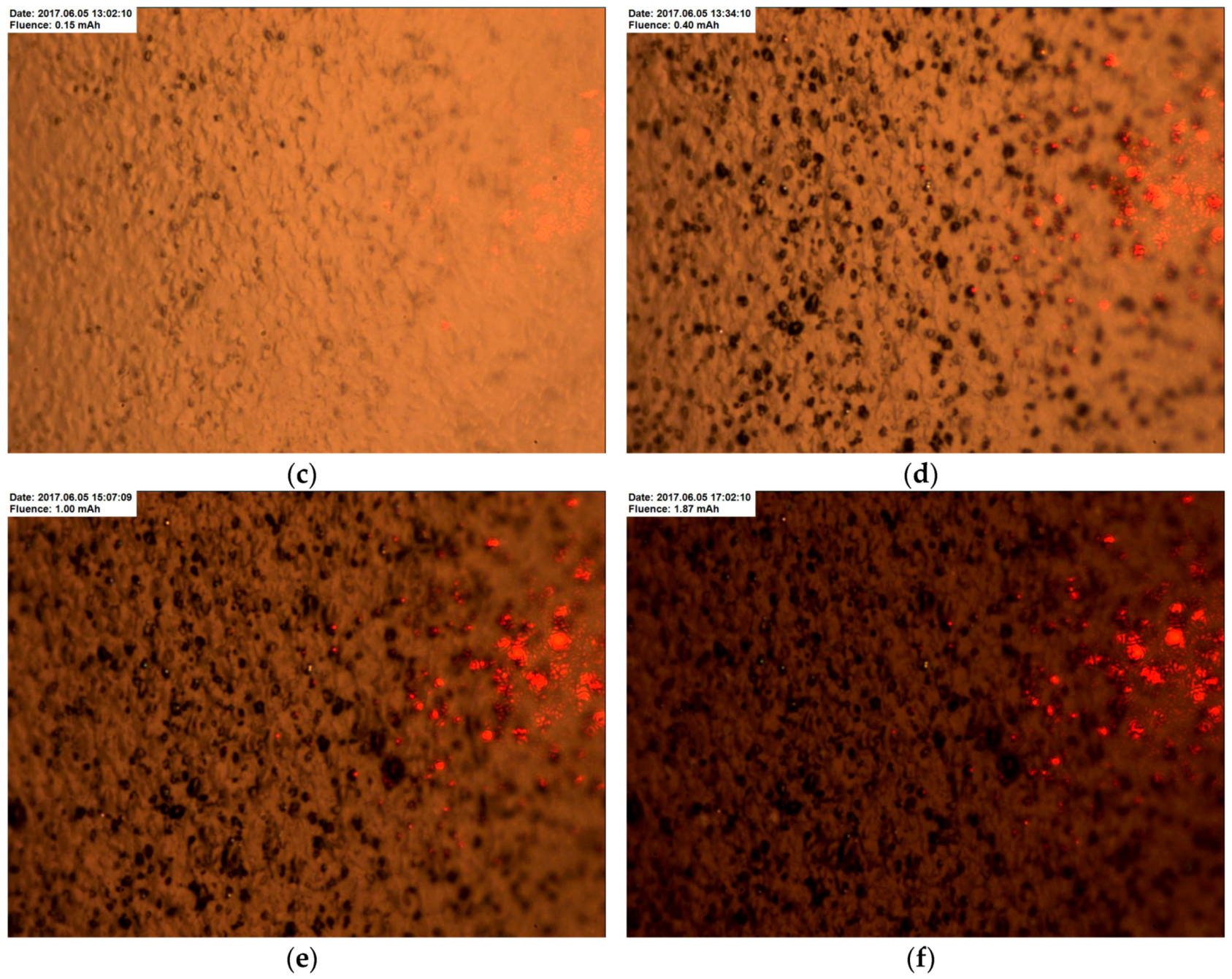
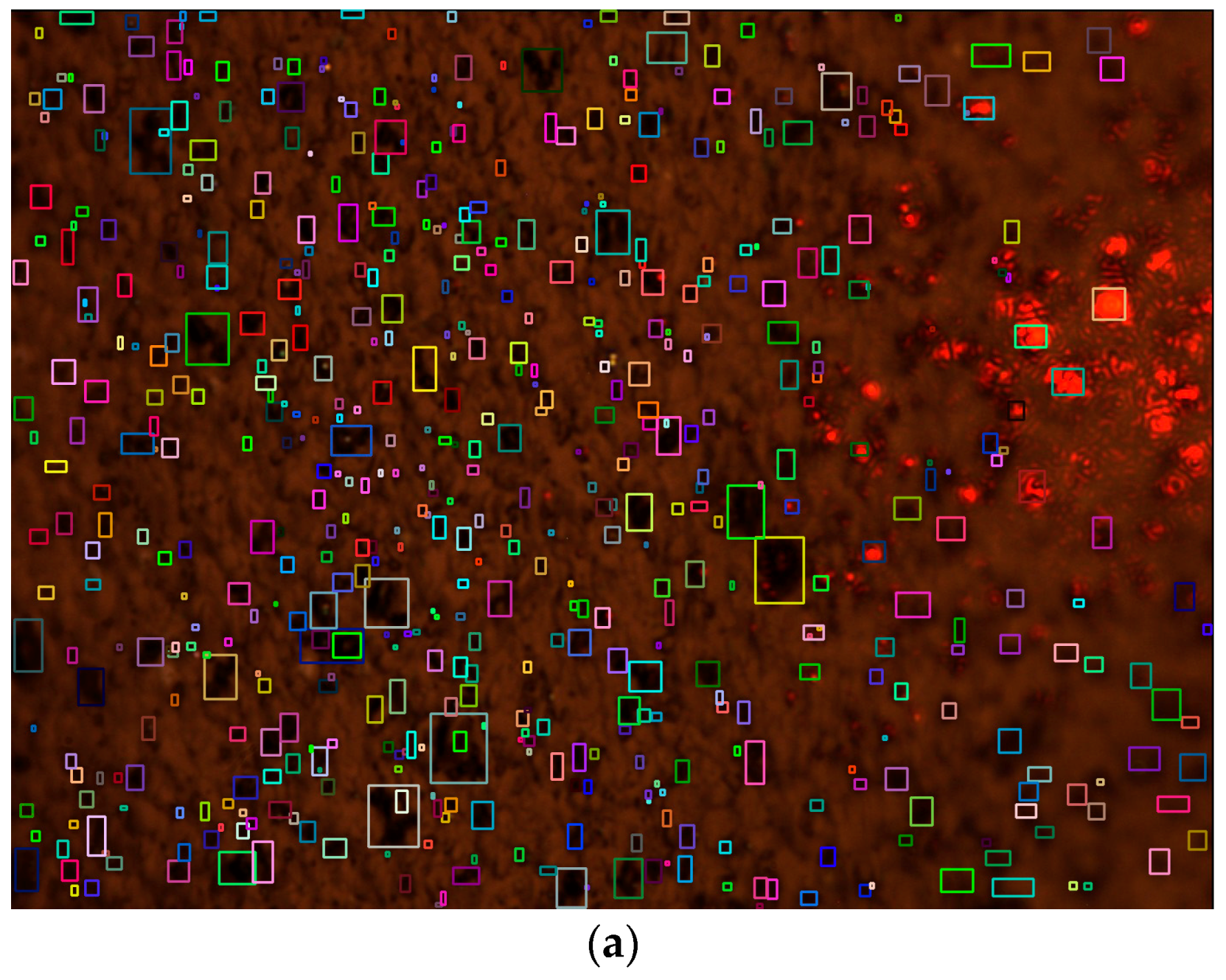
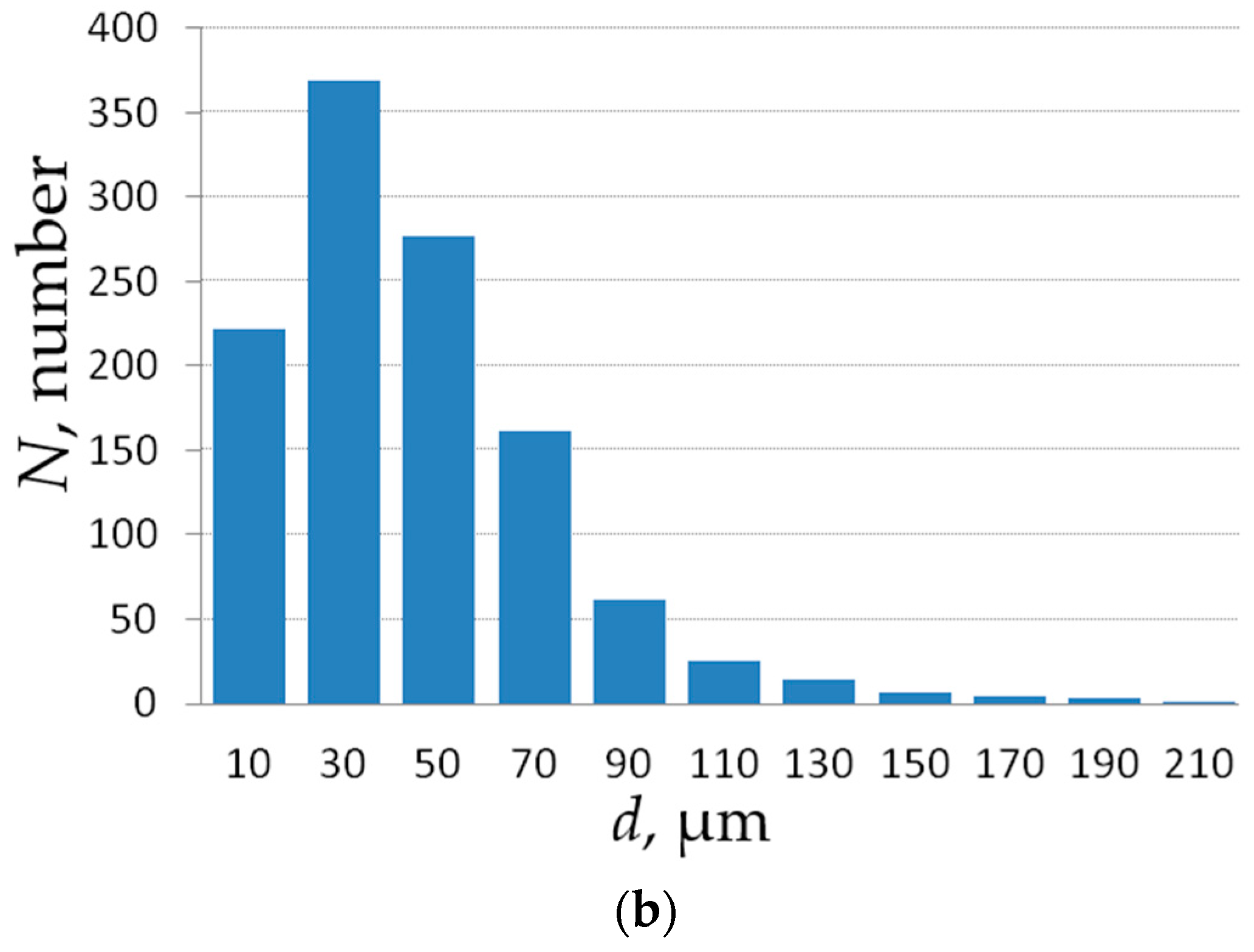
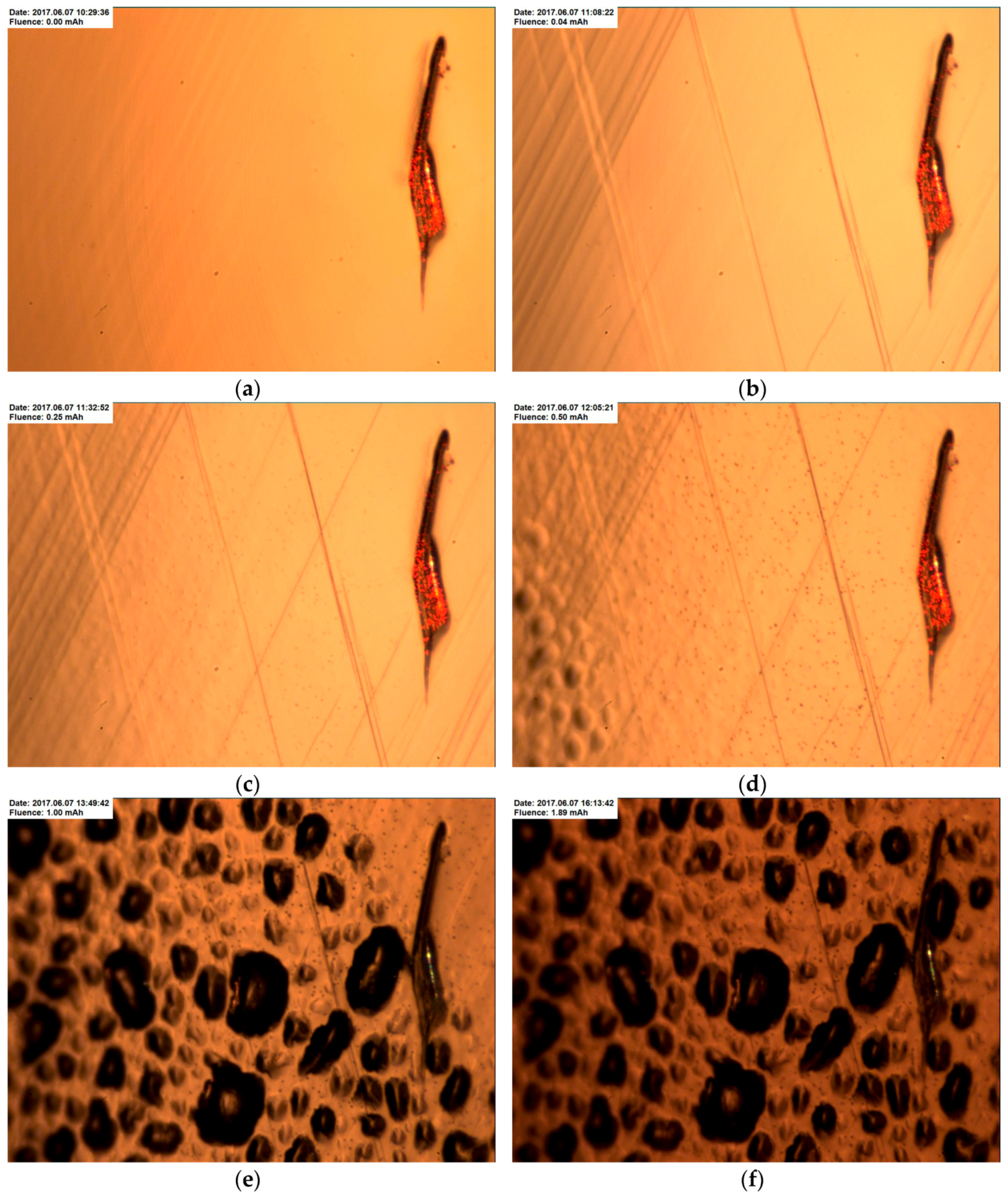



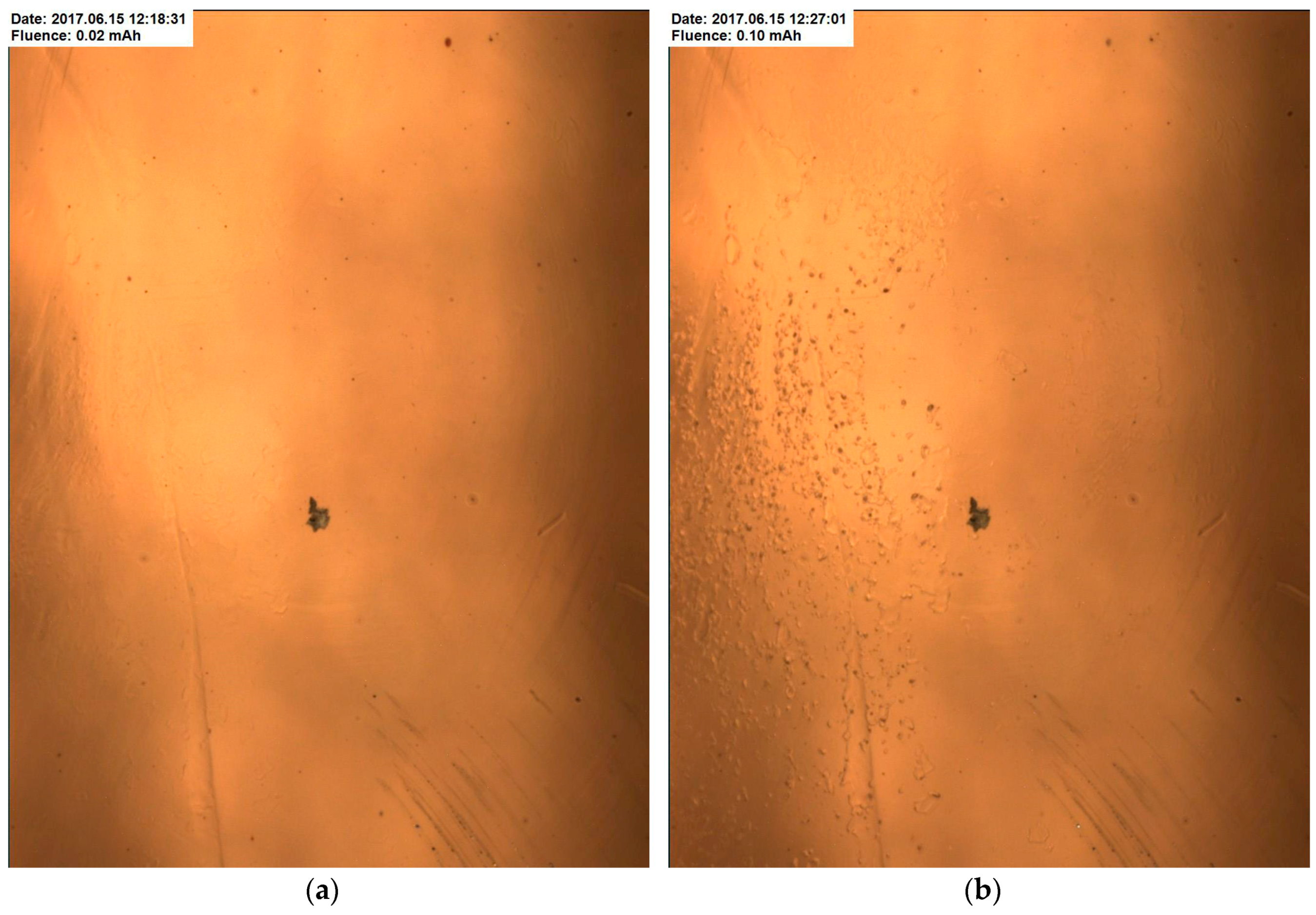
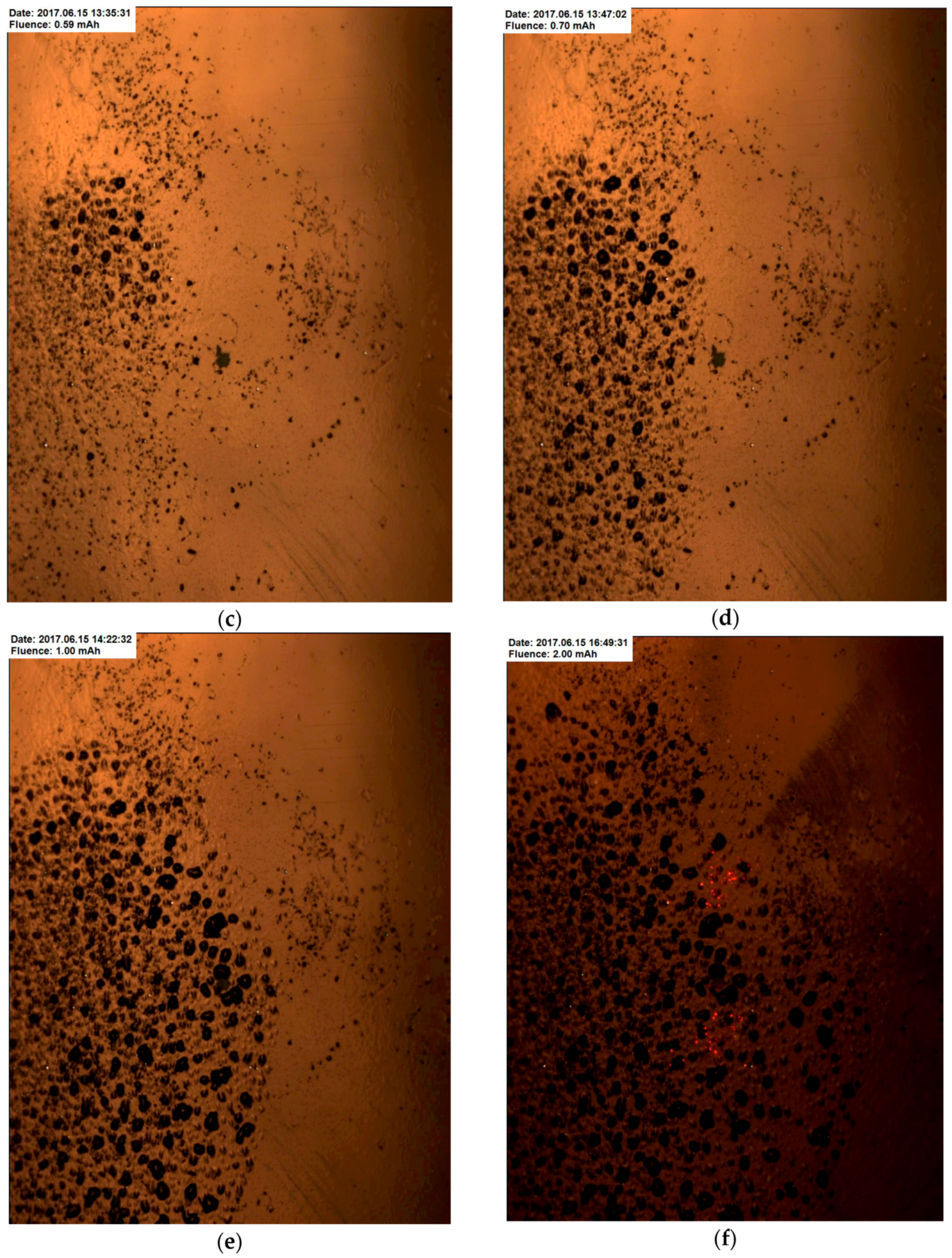
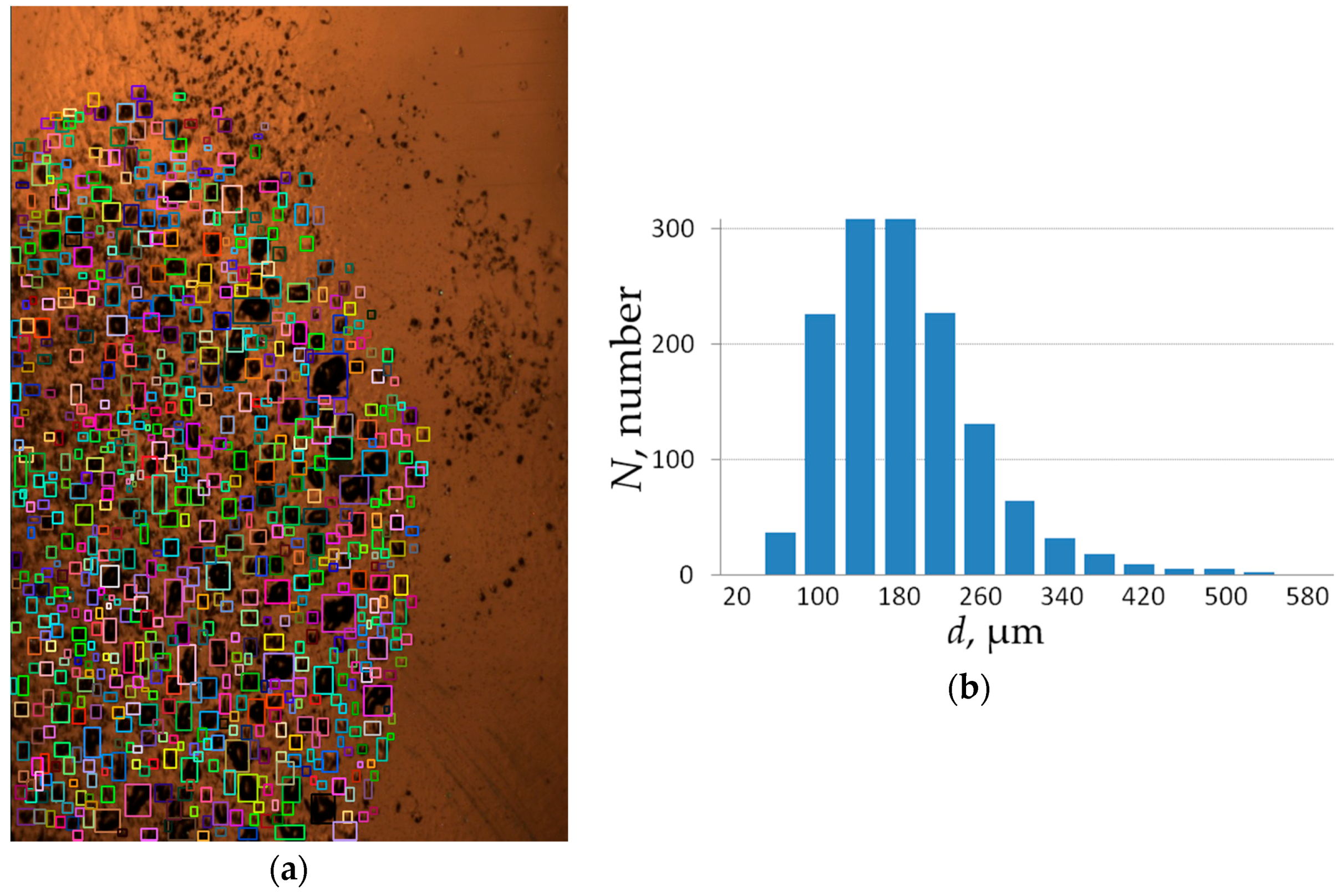
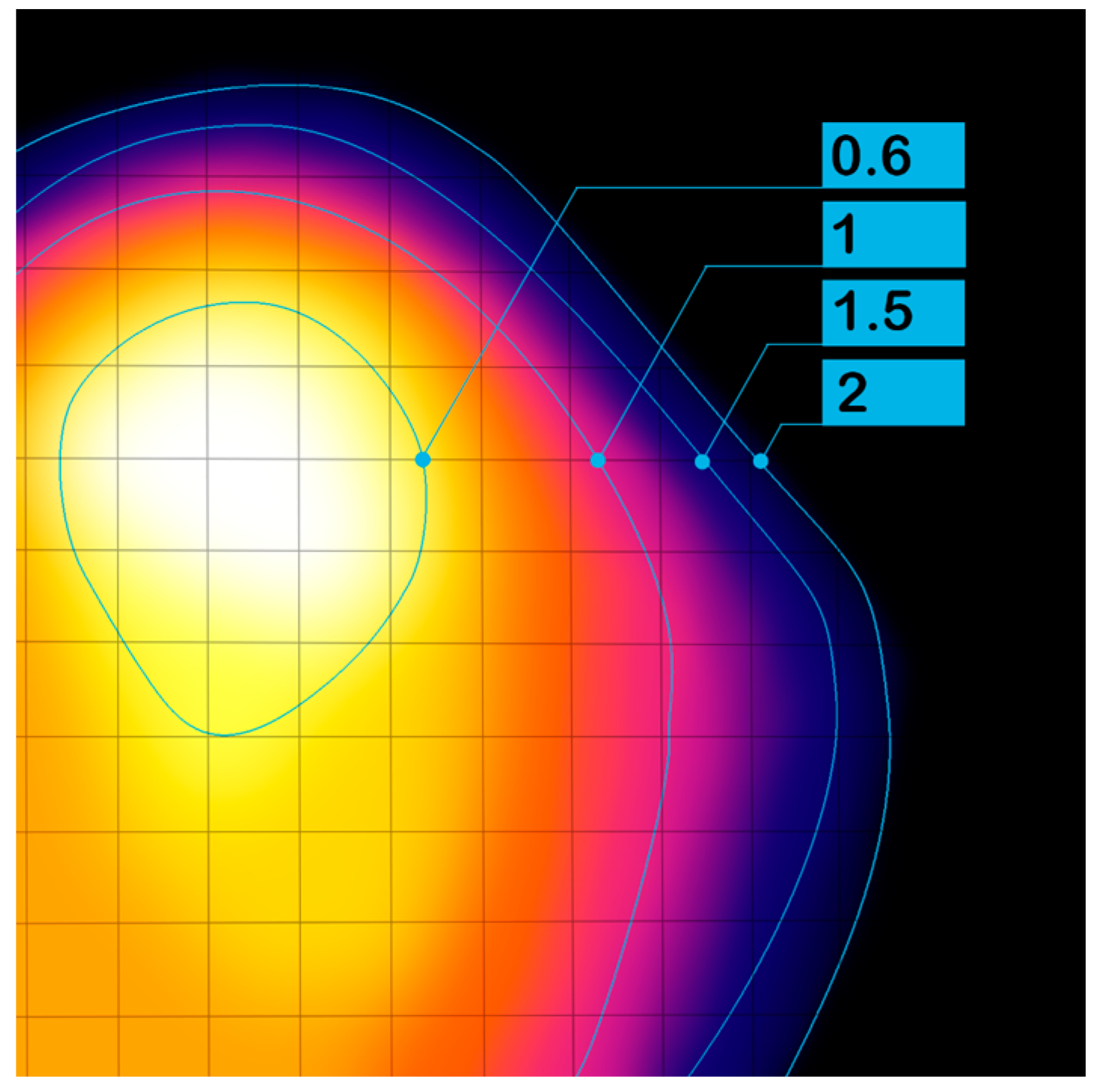
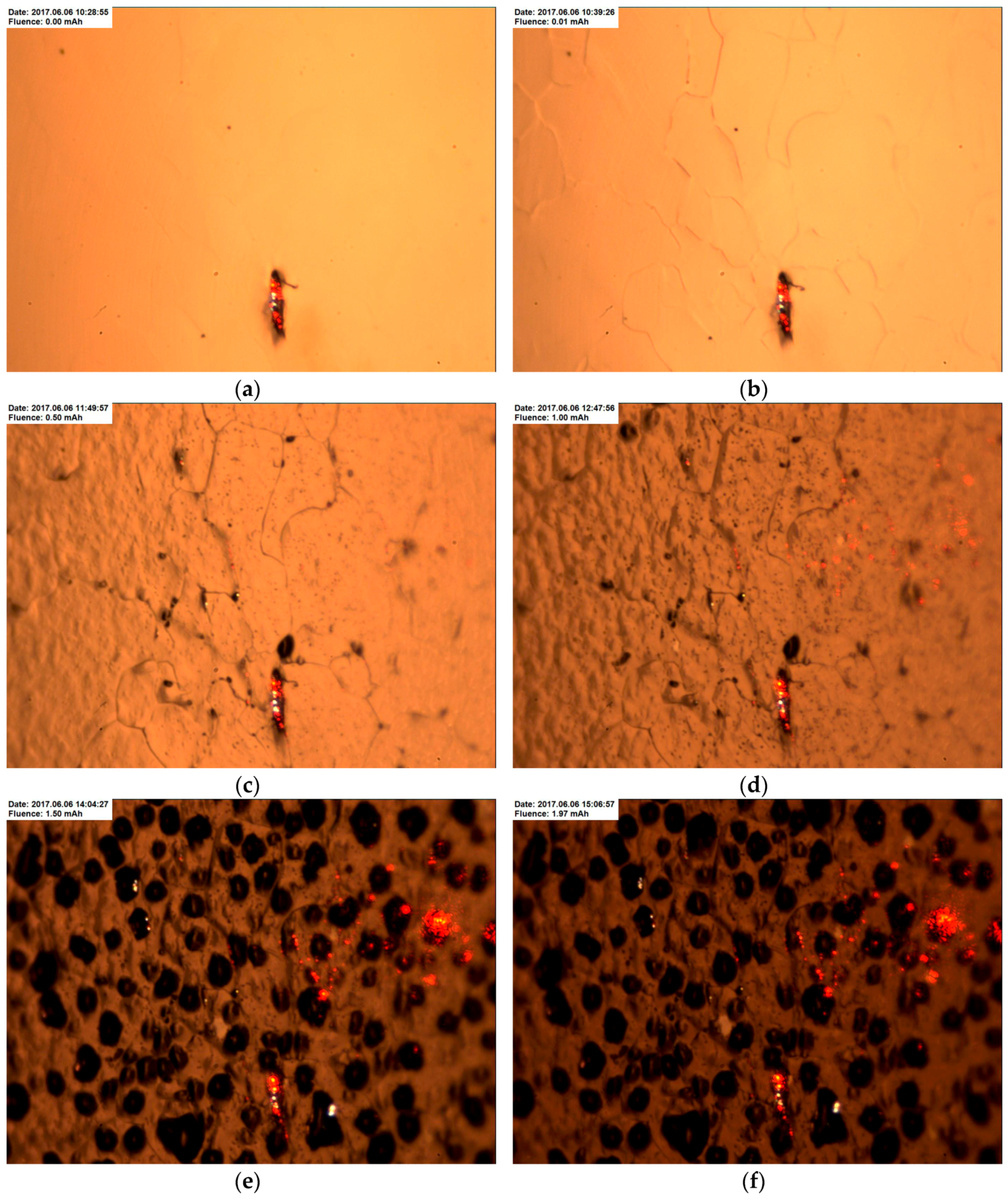


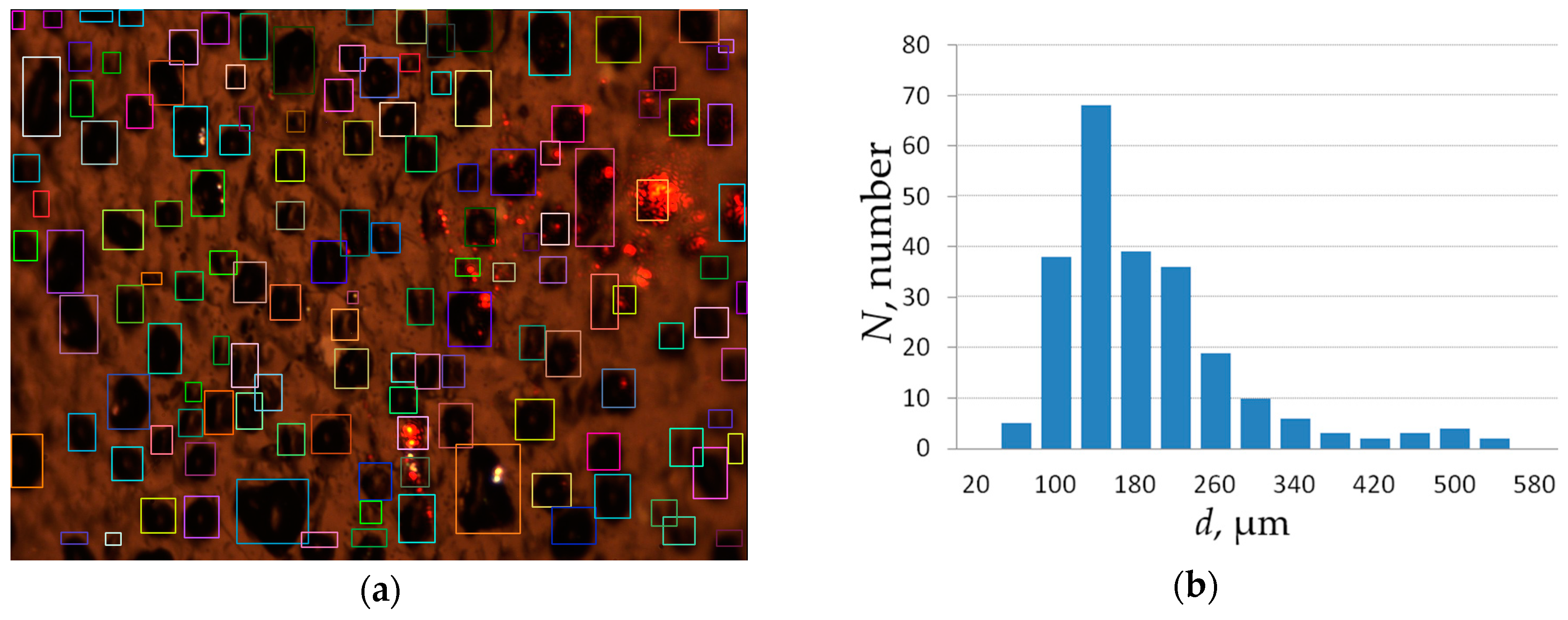
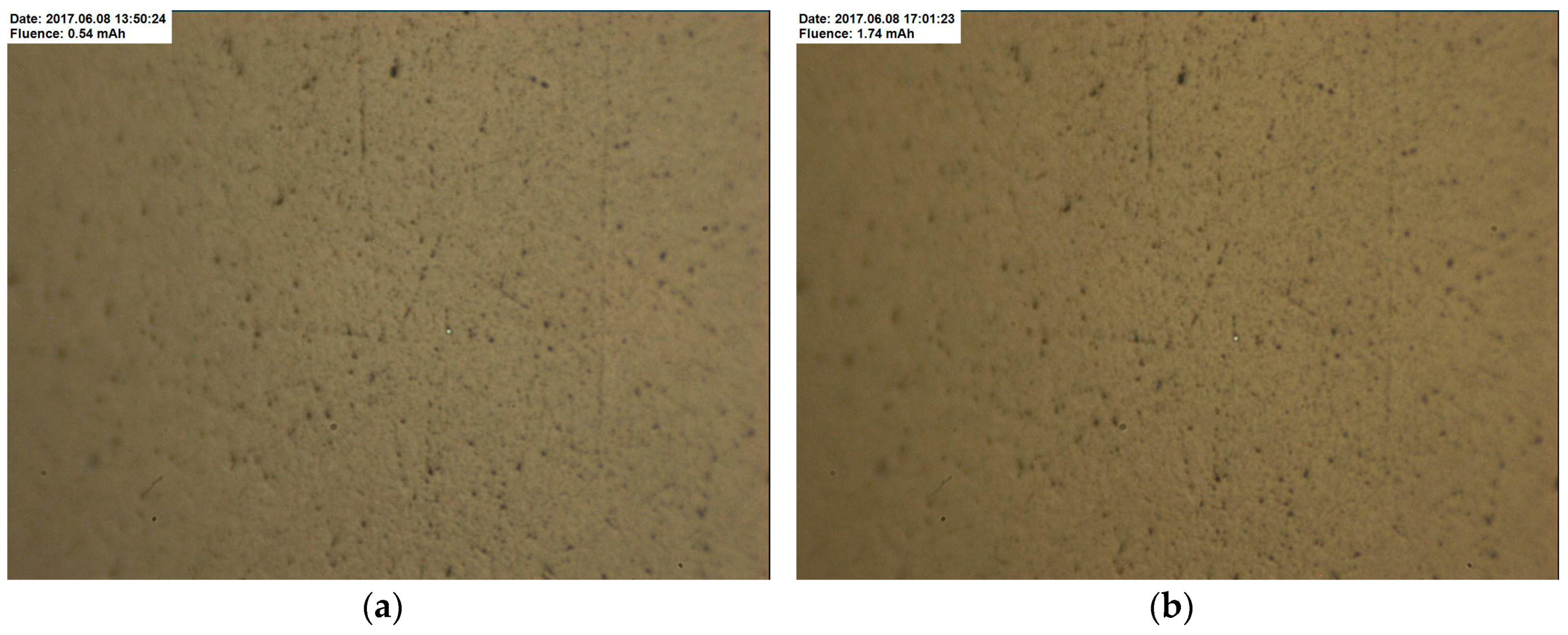
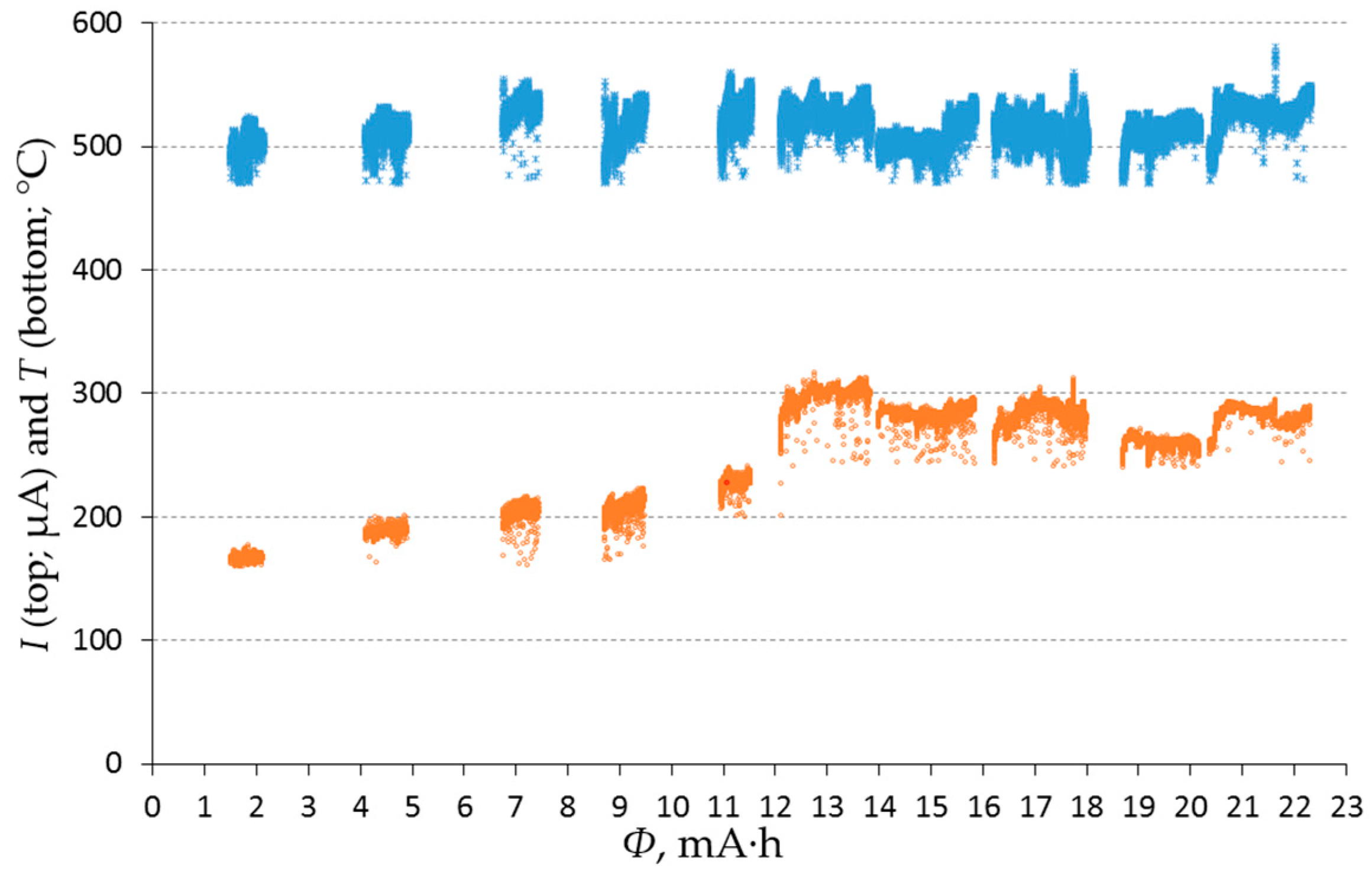

| Sample | 2θ321, ° | d321, Å | a, Å | Δ, Å | FWHM 2, 2θ, ° | CSR 3, nm | State |
|---|---|---|---|---|---|---|---|
| Tantalum reference | 121.351 | 0.8835 | 3.3058 | - | - | - | Polycrystal |
| Non-irradiated | 121.288 | 0.8838 | 3.307(2 1) | 0.001 | 0.546 | 40 | Polycrystal |
| 5 | 121.050 | 0.8848 | 3.311(2) | 0.005 | 0.647 | 33 | Texture [200] |
| 6 | 120.000 | 0.8895 | 3.328(2) | 0.0223 | 0.648 | 33 | Texture [200] |
| Sample No. | Technology | Current, μA | Pyrometer Temperature, °C | Maximum Temperature (Infrared Camera), °C |
|---|---|---|---|---|
| 5 | Explosion welding | 505 ± 16 | 137 ± 9 | - |
| 7 | Soldering | 500 ± 16 | 247 | 360 |
| 8 | Diffusion welding | 505 ± 20 | 155 | 280 |
| 9 | Arc deposition (1:1) | 505 ± 15 | 143 ± 9 | 250 |
| No. | Material | T, °C | Blistering Threshold, 1019 cm−2 | Blistering Size, μm | Features | ||
|---|---|---|---|---|---|---|---|
| Thermistor | Pyrometer | Infrared Camera | |||||
| N/N | Cu, M0 | 263 ± 15 | - | - | 1.5 | - | - |
| N/N | Cu, 99.996% | 263 ± 15 | - | - | 1.5 | - | - |
| 1 | 130 ± 15 | 82 ± 16 | - | 0.45 | 40 ± 20 | - | |
| N/N | Cu, 99.99996%, coarse-grained | 263 ± 15 | - | - | 3 | - | cracks |
| 2 | 130 ± 15 | 83 ± 8 | - | 1.5 | 160 ± 50 | - | |
| 3 | - | - | - | 1.5 | 170 ± 50 | - | |
| 4 | Cu, 99.99996%, fine-grained | 130 ± 15 | 84 ± 12 | - | 3 | 155 ± 45 | - |
| N/N | Ta | 600 | - | - | >5.6 | - | - |
| 5 | Ta-Cu 1 | - | 137 ± 9 | 240 | >5.6 | - | - |
| 6 | - | 160–210 | - | >67 | - | Relief at a fluence of 3.6 × 1020 cm−2 | |
| 7 | Ta-Cu 2 | - | 247 | 360 | >5.6 | - | - |
| 8 | Ta-Cu 3 | - | 155 | 280 | >5.6 | - | - |
| 9 | Ta + Cu 4 | - | 143 ± 9 | 250 | >5.6 | - | - |
© 2017 by the authors. Licensee MDPI, Basel, Switzerland. This article is an open access article distributed under the terms and conditions of the Creative Commons Attribution (CC BY) license (http://creativecommons.org/licenses/by/4.0/).
Share and Cite
Badrutdinov, A.; Bykov, T.; Gromilov, S.; Higashi, Y.; Kasatov, D.; Kolesnikov, I.; Koshkarev, A.; Makarov, A.; Miyazawa, T.; Shchudlo, I.; et al. In Situ Observations of Blistering of a Metal Irradiated with 2-MeV Protons. Metals 2017, 7, 558. https://doi.org/10.3390/met7120558
Badrutdinov A, Bykov T, Gromilov S, Higashi Y, Kasatov D, Kolesnikov I, Koshkarev A, Makarov A, Miyazawa T, Shchudlo I, et al. In Situ Observations of Blistering of a Metal Irradiated with 2-MeV Protons. Metals. 2017; 7(12):558. https://doi.org/10.3390/met7120558
Chicago/Turabian StyleBadrutdinov, Alexander, Timophey Bykov, Sergey Gromilov, Yasuo Higashi, Dmitrii Kasatov, Iaroslav Kolesnikov, Alexey Koshkarev, Alexandr Makarov, Takuya Miyazawa, Ivan Shchudlo, and et al. 2017. "In Situ Observations of Blistering of a Metal Irradiated with 2-MeV Protons" Metals 7, no. 12: 558. https://doi.org/10.3390/met7120558






